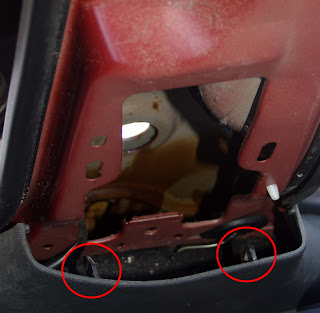Remove the handbrake gaiter and release cable A from the handbrake lever (10 mm. nut)
Underneath the car there is a heat shield which has to be undone in order to get to the connection between cable A and cable B. Unhook cable B.
There is another connection point, close to the brake drum. Unhook it to separate cable B from cable D on the left hand side.
Pull cable B out of the connection point which is located above the rear axle, on the left hand side.
Unhook cable C as well.
There is another connection point for cable C, close to the brake drum.
In order to get to cable D. Remove the brake drum. A 27 mm nut is located underneath the metal lid, in the centre of the drum. Remove the retaining lock ring from cable D, on inside of the drum, unhook cable D and pull it out.
Remember to change the cable guides as well. Parts-number GM: 9191985 or Opel: 526701. These plastic guides will rub the plastic coating of your new cables, if they are slightly worn. If you have a problem with handbrake cables which are not releasing, it might be because of worn out guides.
Put the cables together in this order:
put the 10 mm. nut in place on cable A
push cable A through the handbrake lever and the chassis
clip cable B together with cable A
slide cable B into the connection point at the rear axle
pull cable D (left hand side) through the drum, put the cable clip in place and hook the cable inside the drum
clip cable B together with cable D (left hand side)
slide cable C into the connection point at the rear axle
pull cable D (right hand side) through the drum, put the cable clip in place and hook the cable inside the drum
clip cable C together with cable D (right hand side)
adjust nut at the handbrake lever

























